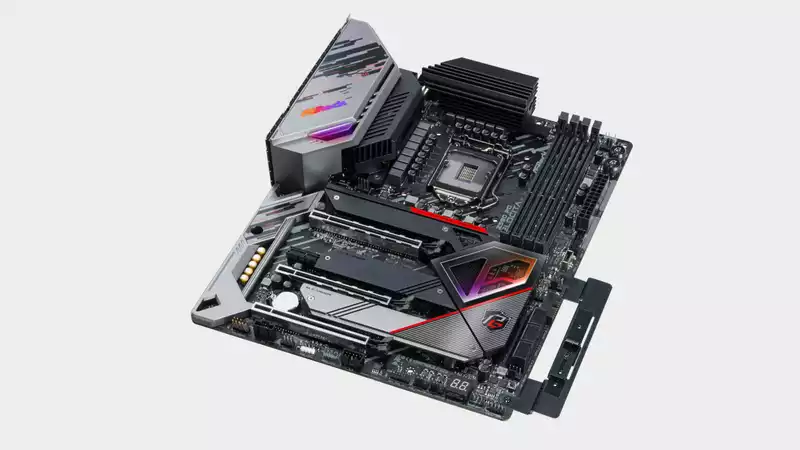The ASRock Z590 PG Velocita is part of the relatively new Velocita product family. It is intended to appeal to gamers who want a premium-class gaming board without having to pay a fortune for add-in cards, water blocks, 10G Lan, etc. Much like Asus' TUF gaming series, the Z590 PG Velocita is a newer addition to the Velocita family.
The X570 Velocita and Z490 Velocita have been well received. But do the new Z590 flavors have what it takes to compete in a fiercely competitive market?
The Z590 Velocita features a bold design with a small PCB inside the chipset heatsink. The metallic gray, red, and black theme looks a bit busy. The heatsink is a bit tasteless, but it works well, and it's not pink polka-dot orange, so that's not a problem.
The Z590 features three M.2 slots and six SATA ports; eight SATA ports is a feature that is becoming increasingly rare as SATA drives become obsolete.
ASRock includes a few additional accessories of note: one is a graphics card fixing bracket to prevent the GPU from sagging, and the USB PCIe bracket, although a bit dated, has several additional ports. Adding these to the 10 ports on the rear I/O brings the total to 12 ports. This is enough for all peripherals, plus a plasma ball for a mad scientist aesthetic. An optional VRM cooling fan is also included, but it is small. Thankfully, as long as the case has airflow, there is no need for one.
Given the steep power requirements of high-end Rocket lake CPUs, especially the power-hungry Adaptive Boost feature of the Core i9 CPUs, we have spent time researching and testing VRM solutions on all the boards we review .
The Velocita has a 14-phase VRM with a 60A choke. This is more than enough current to drive a Core i9 11900K with AVX. It does not match the current capability of more expensive boards, but they are usually designed with extreme overclocking in mind. If so, keep an eye out for the Z590 OC Formula.
Velocita's heatsink is chunky enough, but not so large in surface area; with an AVX-enabled Adaptive Boost load, the VRM showed a temperature of 69°C. This is in the warmer category of boards we tested, but within specs. With a few inexpensive exceptions, we are mostly impressed with the VRMs on the Z590 board.
Rear I/O is particularly well equipped. There is an onboard header, but no USB Gen 2x2 ports. Frankly, we'd prefer to see them on the back panel rather than relying on chassis expansion: in addition to the two USB Gen 2 ports, there are six Gen 1 ports and two 2.0 ports.
Not many boards have dual LAN this time around, which may be a deal-breaker for some users. the Killer AX1675X Wi-Fi 6E and E3100G 2.5G controller. Killer is a bit of a like it or not It tends to be a bit bloated, mostly due to software bloat. It will be interesting to see what happens to the brand now that Intel has taken over Rivet Networks; in addition to the Killer 2.5G Lan, there is a 1G Intel I219V controller. There are also S/PDIF optical outputs, HDMI and DisplayPort connections.
System Performance
Gaming Performance
The board performs as expected when applying Intel's default power settings. AS SSD drive performance tests showed poorer random read and write performance than others. A BIOS update should resolve some of the issues.
On the subject of BIOS, the latest beta version we had on hand at the time of testing produced very slow AVX results. After changing the CPU current setting to unlimited, the board returned the same results as the other Z590s we tested. This indicates that the Core i9 11900K and AB combination is a massive stress test for the board and a less comfortable test for the manufacturer; a 300W+ load is about the same as a 64-core Threadripper.
Velocita passed all of our tests with ease, and in fact, it gained a significant share of the multi-threaded and gaming tests.
At about US$340, the Velocita faces some stiff competition in its price range, but there are advantages. It has powerful I/O (though no 20Gb/s USB on the back) and a decent VRM design for the price.
Velocita is another example of ASRock's tendency to include features here and there that other boards in the same price range do not have. For example, dual LAN, PCIe brackets, and power and reset buttons. These are not game changers, but the little things add up and highlight what the mid-range of this new ASRock board brings to the table.
However, we feel that the Z590 PG Velocita is missing a BIOS or two to reach maturity. It is a bit of a tuning issue. If you're looking for a board at this price point, ASRock has a lot to offer, and a little more love for the firmware would make it even more appealing.
.

Comments